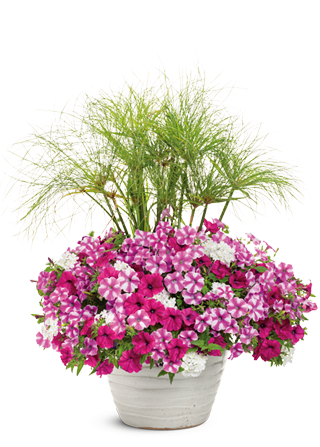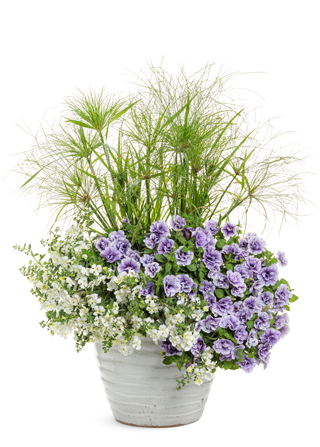
GRACEFUL GRASSES® PRINCE TUT™ CYPERUS IN UPRIGHT CONTAINERS
Prince Tut thrives with consistent moisture and has an extensive root system. When growing it in containers, choose one that is a minimum of 12” in diameter—the larger the better. Self-watering AquaPots® or containers made of glazed clay or other non-porous material are ideal since they will help the soil retain moisture. Scroll down to find recipe ideas as well as best practices for planting and tending our Annual of the Year in upright containers.
Click the images above to learn more about each recipe.
PLANTING YOUR UPRIGHT CONTAINER
- Select a container that is a minimum of 12” diameter, or larger if your growing season is relatively long. A larger container will better accommodate the extensive root system of Prince Tut and make it easier to plant other flowers along with it.
- If you are growing Prince Tut on its own in a container, you can use one that does not have any drainage holes. This will essentially turn your container into a mini bog garden, and the papyrus will love all that extra moisture. But if you are pairing Prince Tut with other plants in a container, it must have drainage holes since the other plants will require it.
- Start by positioning your Prince Tut papyrus as the thriller in your container. If it will be seen from all sides, plant it in the middle. If it will be set up against a wall, plant it in the back.
- Depending on the size of your container, you may need just two more plants to fill out the edges or several more. Space them a few inches apart around Prince Tut to give their roots room to grow.
- Use a good quality potting soil in your container. If you are pairing Prince Tut with other moisture-loving varieties, consider using a moisture control potting soil.
- Mix a bit of continuous release plant food into the potting soil before you add the plants. This will ensure a small amount of nutrients is available to the plants throughout the growing season.
- Water your newly planted container immediately to help the soil settle in around the plants’ roots.


